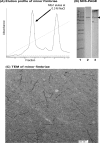The native 67-kilodalton minor fimbria of Porphyromonas gingivalis is a novel glycoprotein with DC-SIGN-targeting motifs
- PMID: 20562309
- PMCID: PMC2916435
- DOI: 10.1128/JB.00275-10
The native 67-kilodalton minor fimbria of Porphyromonas gingivalis is a novel glycoprotein with DC-SIGN-targeting motifs
Abstract
We recently reported that the oral mucosal pathogen Porphyromonas gingivalis, through its 67-kDa Mfa1 (minor) fimbria, targets the C-type lectin receptor DC-SIGN for invasion and persistence within human monocyte-derived dendritic cells (DCs). The DCs respond by inducing an immunosuppressive and Th2-biased CD4(+) T-cell response. We have now purified the native minor fimbria by ion-exchange chromatography and sequenced the fimbria by tandem mass spectrometry (MS/MS), confirming its identity and revealing two putative N-glycosylation motifs as well as numerous putative O-glycosylation sites. We further show that the minor fimbria is glycosylated by ProQ staining and that glycosylation is partially removed by treatment with beta(1-4)-galactosidase, but not by classic N- and O-linked deglycosidases. Further monosaccharide analysis by gas chromatography-mass spectrometry (GC-MS) confirmed that the minor fimbria contains the DC-SIGN-targeting carbohydrates fucose (1.35 nmol/mg), mannose (2.68 nmol/mg), N-acetylglucosamine (2.27 nmol/mg), and N-acetylgalactosamine (0.652 nmol/mg). Analysis by transmission electron microscopy revealed that the minor fimbria forms fibers approximately 200 nm in length that could be involved in targeting or cross-linking DC-SIGN. These findings shed further light on molecular mechanisms of invasion and immunosuppression by this unique mucosal pathogen.
Figures




Similar articles
-
Targeting of DC-SIGN on human dendritic cells by minor fimbriated Porphyromonas gingivalis strains elicits a distinct effector T cell response.J Immunol. 2009 Nov 1;183(9):5694-704. doi: 10.4049/jimmunol.0901030. Epub 2009 Oct 14. J Immunol. 2009. PMID: 19828628 Free PMC article.
-
Isolation and characterization of a minor fimbria from Porphyromonas gingivalis.Infect Immun. 1996 Nov;64(11):4788-94. doi: 10.1128/iai.64.11.4788-4794.1996. Infect Immun. 1996. PMID: 8890240 Free PMC article.
-
Porphyromonas gingivalis evasion of autophagy and intracellular killing by human myeloid dendritic cells involves DC-SIGN-TLR2 crosstalk.PLoS Pathog. 2015 Feb 13;10(2):e1004647. doi: 10.1371/journal.ppat.1004647. eCollection 2015 Feb. PLoS Pathog. 2015. PMID: 25679217 Free PMC article.
-
C-type lectin DC-SIGN: an adhesion, signalling and antigen-uptake molecule that guides dendritic cells in immunity.Cell Signal. 2010 Oct;22(10):1397-405. doi: 10.1016/j.cellsig.2010.03.018. Epub 2010 Apr 2. Cell Signal. 2010. PMID: 20363321 Free PMC article. Review.
-
DC-SIGN: a novel HIV receptor on DCs that mediates HIV-1 transmission.Curr Top Microbiol Immunol. 2003;276:31-54. doi: 10.1007/978-3-662-06508-2_2. Curr Top Microbiol Immunol. 2003. PMID: 12797442 Review.
Cited by
-
A Tale of Two Fimbriae: How Invasion of Dendritic Cells by Porphyromonas gingivalis Disrupts DC Maturation and Depolarizes the T-Cell-Mediated Immune Response.Pathogens. 2022 Mar 8;11(3):328. doi: 10.3390/pathogens11030328. Pathogens. 2022. PMID: 35335652 Free PMC article. Review.
-
Dendritic cells a critical link to alveolar bone loss and systemic disease risk in periodontitis: Immunotherapeutic implications.Periodontol 2000. 2022 Jun;89(1):41-50. doi: 10.1111/prd.12428. Epub 2022 Mar 4. Periodontol 2000. 2022. PMID: 35244951 Free PMC article. Review.
-
Oral community interactions of Filifactor alocis in vitro.PLoS One. 2013 Oct 3;8(10):e76271. doi: 10.1371/journal.pone.0076271. eCollection 2013. PLoS One. 2013. PMID: 24098460 Free PMC article.
-
Identification of functional domains of the minor fimbrial antigen involved in the interaction of Porphyromonas gingivalis with oral streptococci.Mol Oral Microbiol. 2020 Apr;35(2):66-77. doi: 10.1111/omi.12280. Epub 2020 Feb 13. Mol Oral Microbiol. 2020. PMID: 31994329 Free PMC article.
-
High-throughput sequencing reveals key genes and immune homeostatic pathways activated in myeloid dendritic cells by Porphyromonas gingivalis 381 and its fimbrial mutants.Mol Oral Microbiol. 2016 Feb;31(1):78-93. doi: 10.1111/omi.12131. Epub 2015 Oct 16. Mol Oral Microbiol. 2016. PMID: 26466817 Free PMC article.
References
-
- Abu-Qarn, M., J. Eichler, and N. Sharon. 2008. Not just for Eukarya anymore: protein glycosylation in Bacteria and Archaea. Curr. Opin. Struct. Biol. 18:544-550. - PubMed
-
- Aduse-Opoku, J., J. M. Slaney, A. Hashim, A. Gallagher, R. P. Gallagher, M. Rangarajan, K. Boutaga, M. L. Laine, A. J. Van Winkelhoff, and M. A. Curtis. 2006. Identification and characterization of the capsular polysaccharide (K-antigen) locus of Porphyromonas gingivalis. Infect. Immun. 74:449-460. - PMC - PubMed
-
- Appelmelk, B. J., I. van Die, S. J. van Vliet, C. M. Vandenbroucke-Grauls, T. B. Geijtenbeek, and Y. van Kooyk. 2003. Cutting edge: carbohydrate profiling identifies new pathogens that interact with dendritic cell-specific ICAM-3-grabbing nonintegrin on dendritic cells. J. Immunol. 170:1635-1639. - PubMed
-
- Arai, M., N. Hamada, and T. Umemoto. 2000. Purification and characterization of a novel secondary fimbrial protein from Porphyromonas gingivalis strain 381. FEMS Microbiol. Lett. 193:75-81. - PubMed
Publication types
MeSH terms
Substances
Grants and funding
LinkOut - more resources
Full Text Sources
Medical
Research Materials
Miscellaneous

